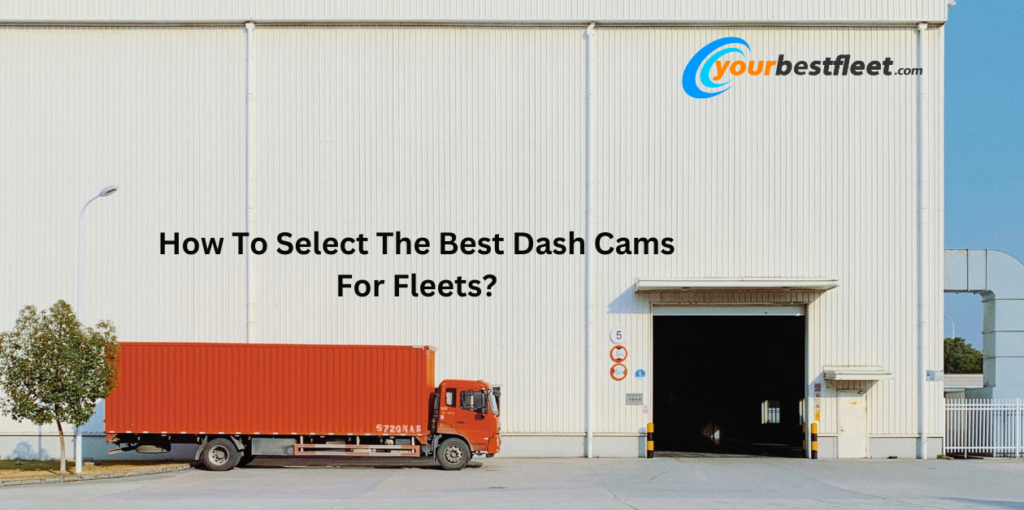Key Takeways
Dash cameras improve fleet safety by recording incidents, tracking drivers, and providing clear video evidence.
Key features like high-resolution video, GPS tracking, and cloud storage are essential for effective monitoring.
Fleet dash cameras provide real-time monitoring and automatic alerts, making them more efficient than consumer models.
A dash camera is essential for fleet management to track drivers, record incidents, and enhance security. Choosing the right dash camera depends on key features like high-resolution recording, GPS tracking, cloud storage, and live streaming. Advanced options include driver alerts, night vision, and AI-powered safety tools for better monitoring.
The right dash camera improves fleet efficiency, reduces risks, and provides clear video evidence when needed.
What Are the Tips For Choosing The Right Dash Camera

High-Resolution Video Quality
High-Resolution Video Quality ensures a dash camera records in 1080p, 2K, or 4K resolution for clear footage. It helps capture license plates, road signs, and other details. This improves video evidence for accidents and disputes.
GPS Tracking and Location Data
GPS Tracking and Location Data allow a dash camera to monitor vehicle routes and speed. It helps fleet managers track movements and driving behavior in real time. This feature is useful for accident investigations and route planning.
Cloud Storage and Remote Access
Cloud Storage and Remote Access enable a dash camera to save videos securely online. It prevents data loss from theft, damage, or memory failure. Remote access allows users to review footage anytime from a connected device.
Night Vision and Low-Light Recording
Night Vision and Low-Light Recording allow a dash camera to capture clear footage in dark conditions. Infrared sensors or enhanced lenses improve visibility at night. This ensures important details are recorded in poor lighting.
AI-Powered Safety Features
AI-Powered Safety Features help a dash camera detect driver fatigue, lane departures, and unsafe behavior. Real-time alerts notify drivers to correct risky actions. AI-driven monitoring improves safety and reduces accidents.
What Are The Benefits Of Dash Camera
The Benefit Of Dash Camera is it records video while driving to provide clear accident evidence. It helps prevent false claims by capturing real-time incidents. GPS tracking in a dash camera shows vehicle location and speed. Night vision allows clear recording in low-light conditions.
Motion detection records movement around a parked vehicle for security. AI alerts warn drivers about unsafe driving to prevent accidents.
What Are The Different Types Of Dash Camera
Front-Facing Dash Camera
A front-facing dash camera records everything happening in front of the vehicle. It captures accidents, road conditions, and traffic violations. This type is useful for personal vehicles and fleet management.

Dual-Facing Dash Camera
A dual-facing dash camera records both the road and the driver inside the vehicle. It helps fleet managers monitor driver behavior and detect distractions. This improves safety by ensuring drivers stay focused and responsible.
Rear Dash Camera
A rear dash camera captures footage from the back of the vehicle. It records rear-end collisions, parking accidents, and hit-and-run incidents. This type adds extra security and evidence for liability protection.

Interior Dash Camera
An interior dash camera records inside the vehicle, capturing passengers and driver interactions. It is ideal for taxis, rideshare services, and commercial fleets. This type helps resolve disputes and ensures passenger safety.

AI-Powered Dash Camera
An AI-powered dash camera detects unsafe driving behaviors like speeding, harsh braking, and fatigue. It provides real-time alerts to help drivers prevent accidents. This type is widely used in commercial fleets for advanced safety monitoring.
Why Choose Fleet Over Consumer Dash Camera
Fleet dash cameras offer real-time monitoring and automatic alerts for unsafe driving. They detect behaviors like fatigue, phone use, speeding, and harsh braking. Video footage is auto-uploaded to the cloud for easy access. Telematics integration helps track vehicle movement and driving habits.
Fleet managers can review incidents without searching through hours of footage. These dash cameras improve safety, prevent false claims, and protect drivers.
Best Practices For Implementing Dash Cams In Fleet Operations
Selecting the Right Dash Camera
Selecting the right dash camera requires identifying fleet needs and key features. Consider factors like video quality, GPS tracking, and cloud storage. Ensure it fits the budget, installation requirements, and long-term use.
Training Drivers on Dash Camera Use
Training drivers on dash camera usage helps them understand its purpose and benefits. Provide clear guidelines on proper usage and safety policies. Address concerns about privacy to ensure smooth adoption.
Establishing Data Access and Privacy Policies
Establishing data access and privacy policies ensures transparency and security. Clearly define who can access recordings and how they will be used. Inform drivers about compliance rules and consequences of misuse.

Performing Regular Maintenance Checks
Performing regular maintenance checks keeps the dash camera working properly. Conduct routine inspections to detect malfunctions or storage issues. Promptly fix problems to avoid missing important footage.
Communicating with Drivers for Better Adoption
Communicating with drivers about dash camera benefits builds trust and cooperation. Address concerns related to privacy and monitoring. Emphasize that cameras enhance safety and improve fleet efficiency.
Also Read :- 7 Best Dashcams with Parking Mode for Truckers/Fleet
Conclusion
A dash camera records incidents, tracks drivers, and improves security. Choosing the right one requires high-resolution video, GPS tracking, and cloud storage. Different types, like front-facing, dual-facing, and AI-powered, offer various monitoring options. Fleet models provide real-time tracking, alerts, and cloud storage for easy access. Proper setup with training, maintenance, and clear policies ensures efficiency.
A dash camera helps prevent false claims and enhances fleet operations.
James Johnson is a former truck driver who now works as a writer, specializing in the trucking industry. With over 15 years of experience on the road, James has a unique perspective on the challenges and opportunities faced by truck drivers and the trucking industry as a whole. His writing focuses on issues such as safety, regulation, and the latest industry trends. His work has been featured in several trucking publications and he has received recognition for his contributions to the industry. In his free time, James still enjoys being around trucks and often attends truck shows and other industry events.


